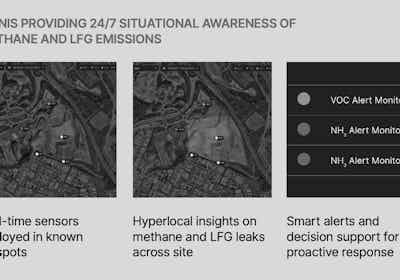Unraveling the Concerns Surrounding Methane and Landfill Gas (LFG) in Landfills
Methane, primarily produced through the anaerobic decomposition of organic waste in landfills, is significantly more effective at trapping heat in the atmosphere than carbon dioxide. This makes it a critical focus for mitigating climate change. Landfill gas, composed of roughly 50% methane, 50% carbon dioxide, and trace amounts of other gases, is a concern not only due to its contribution to global warming but also because of the potential health hazards it poses to nearby communities. Effective monitoring and management of LFG are therefore essential for both environmental and public health.
How Do Landfills Repurpose Methane for a Greener Future?
Landfills can turn a potential environmental liability into a resource by capturing and processing methane. Modern landfills can convert this gas into energy, which can be sold or used to power landfill operations. Methane capture systems are installed to collect the gas, which is then processed and either flared off or converted into electricity through generators. This practice not only mitigates the emission of a harmful greenhouse gas but also provides a renewable energy source, embodying a circular economy approach.
Current Methods for Monitoring and Managing Methane Leaks at Landfills
The traditional methods of monitoring methane leaks at landfills involve a combination of ground-based and aerial technologies:
Ground-Based Monitoring
Gas Extraction Systems: These systems collect LFG via a network of wells and pipes. While effective, they require regular maintenance and monitoring.
Surface Emission Monitoring: Hand-held devices are used to measure methane concentrations at the landfill surface. This method is labour-intensive and provides limited spatial coverage.
Aerial Monitoring
Drones: Equipped with methane sensors, drones can cover large areas and provide detailed aerial mapping of methane emissions. This technology, while effective, can be cost-prohibitive and requires skilled operation.
Satellite Imagery: Advanced satellites offer broad coverage and frequent monitoring. However, the resolution may not be sufficient for pinpointing exact leak locations.
While these traditional methods offer valuable insights, they often lack real-time analysis and actionable intelligence. Current methods are inefficient, with available data collection techniques being labor-intensive and time-consuming. This inefficiency hampers the ability to make quick, informed decisions, highlighting the need for more streamlined and automated approaches. This is where innovative solutions like Omnis come into play.
Real-time Insights for Better Landfill Gas Management
Envirosuite’s Omnis can offer a better alternative to methane detection by providing landfill operators with situational awareness of their site emissions and problematic areas in real time. By leveraging advanced technology and data analytics, Omnis ensures optimal methane capture, enhancing both environmental responsibility and profitability.

Why choose Omnis as an alternative to methane detection at your waste operation?
Real-time insights on LFG and methane: Receive instant updates on methane levels and other critical parameters to develop a plan for leaks and systematically act when they happen.
Powerful site-wide visualisation: Gain a comprehensive view of landfill operations to pinpoint inefficiencies and optimise processes.
Cost-effective methane detection: Automated and rapid calculations link emission sources and measured effect almost instantly to enable necessary action without the need for high-grade hardware solutions.
Optimise costs and support revenue: Utilise powerful tools to interpret data and identify trends, maximising opportunities for methane capture.
Maintain compliance: Effortlessly stay compliant with regulatory standards through detailed, automated reporting.
Better alternative to available methods: Deploy a less labour-intensive method of detecting emissions sources than other methods such as drones.

Book a Demo of Omnis today
Innovative technologies such as Omnisnot only boosts operational efficiency but also underscores a commitment to environmental responsibility and sustainability, essential for staying competitive in a dynamic industry landscape.
Don't miss the opportunity to enhance the environmental management strategy at your site. Book a demo today!
